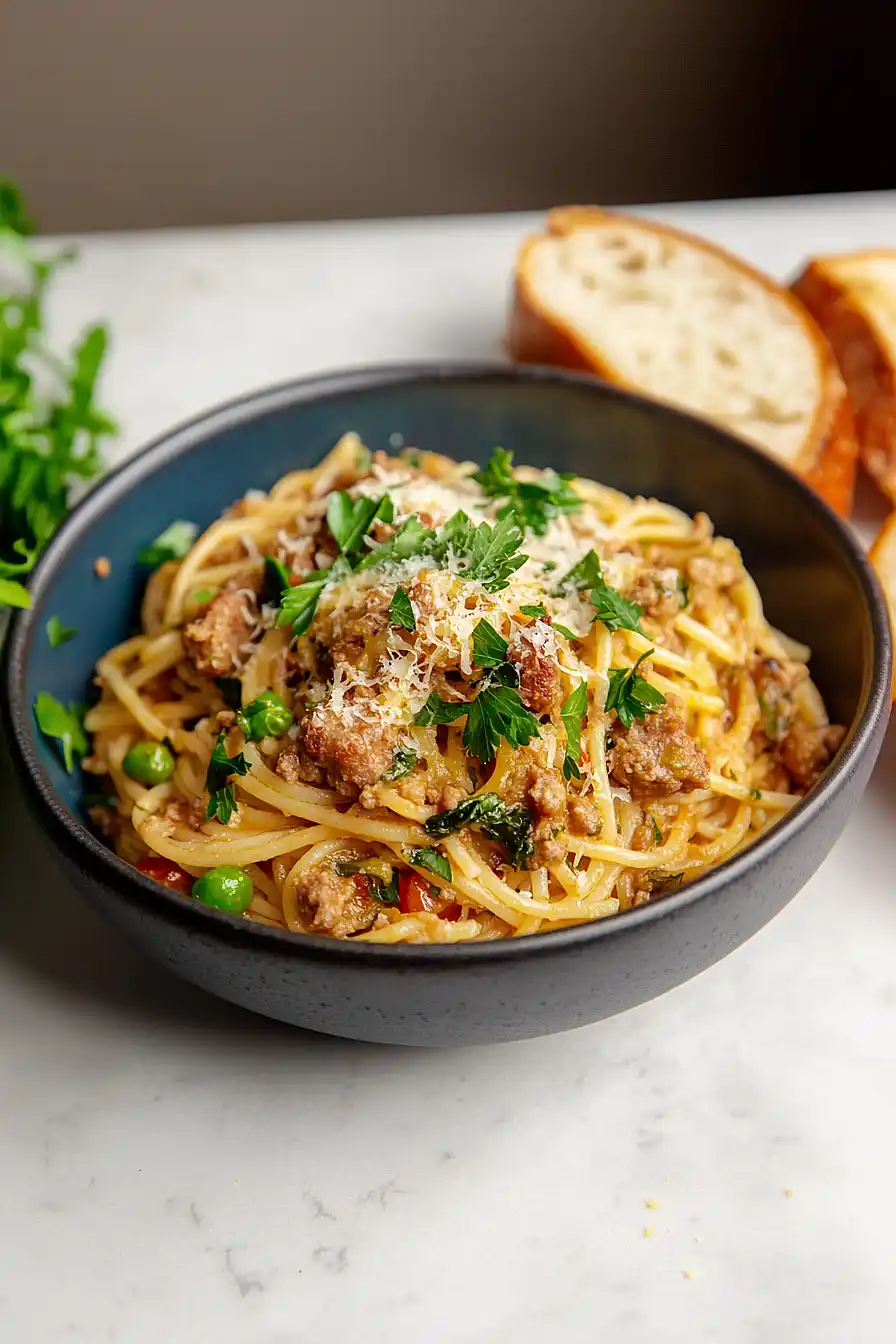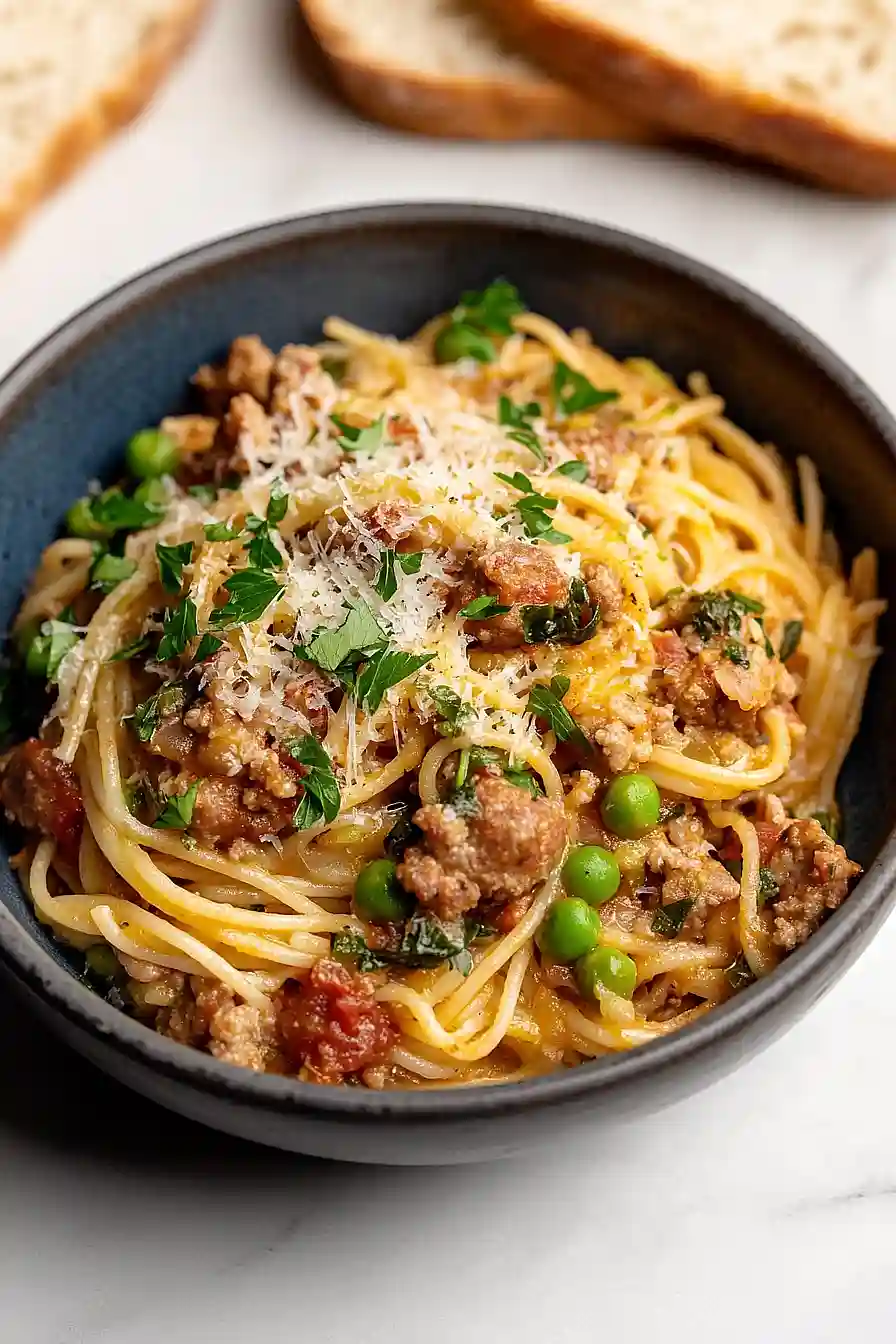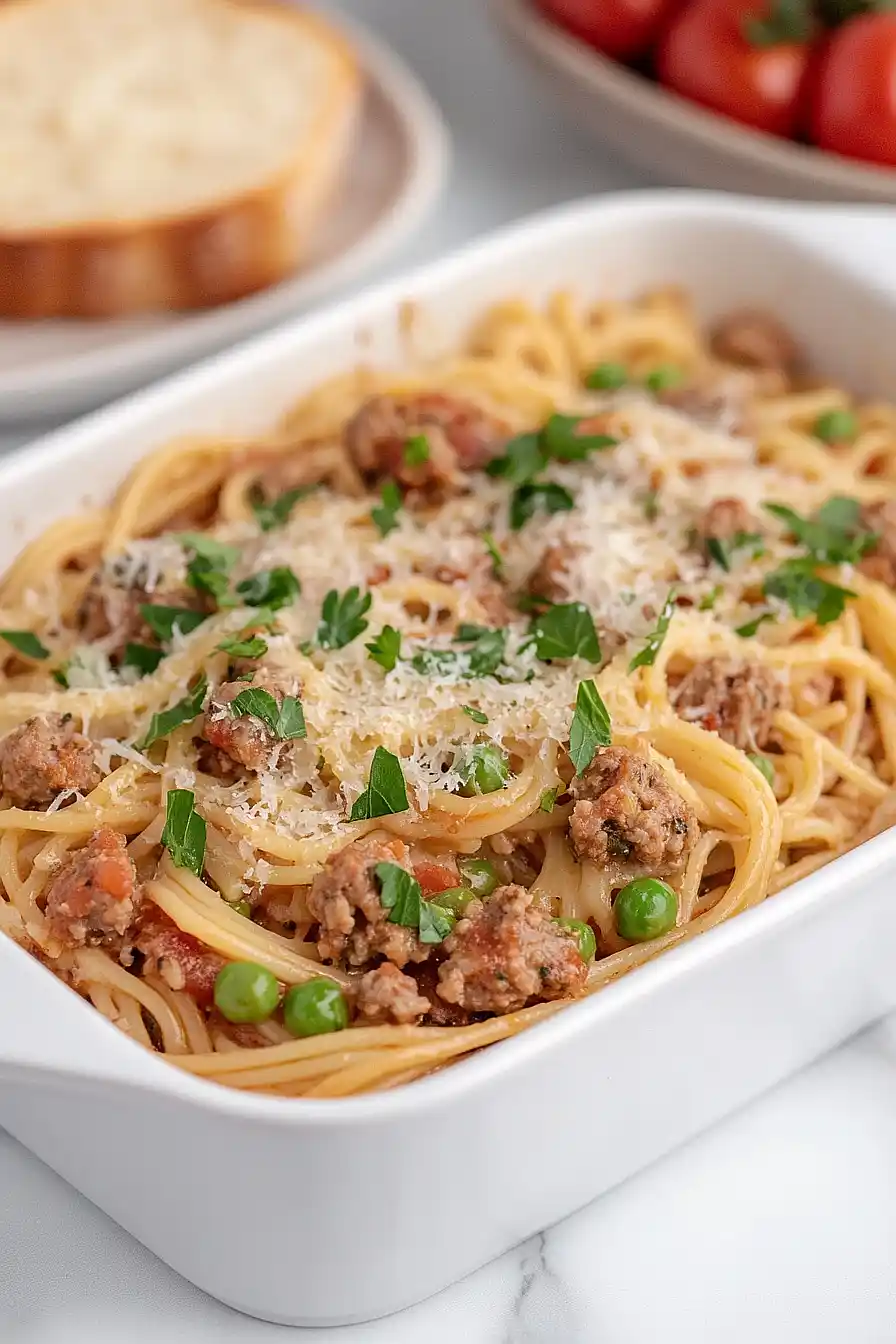There’s something so comforting about a big plate of spaghetti with sausage. It’s one of those meals that always reminds me of Sunday dinners growing up, when Mom would let the sauce simmer all afternoon. These days, I make this dish at least twice a month for my family – it’s reliable, filling, and everyone leaves the table happy. The best part? It’s not fussy at all. You can stir the sauce while helping with homework or catching up on the day’s events. Even better, there’s usually enough left over for lunch the next day, and I swear it tastes even better then. If you’re looking for a go-to pasta dish that’ll make your kitchen smell amazing and keep hungry tummies satisfied, this one’s for you.
Why You’ll Love This Sausage Spaghetti
- Quick weeknight dinner – Ready in under an hour, this pasta dish is perfect for those busy evenings when you need a satisfying meal without spending hours in the kitchen.
- Basic pantry ingredients – Most of these ingredients are kitchen staples you likely already have on hand, making this an easy go-to recipe when you haven’t had time to shop.
- Kid-friendly meal – The combination of mild Italian sausage and pasta is always a hit with children, while adults can adjust the heat level with chili flakes to their liking.
- One-pot simplicity – With just one main cooking pot (plus one for pasta), cleanup is minimal, making this perfect for busy families or anyone who doesn’t want to deal with lots of dishes.
What Kind of Pork Sausages Should I Use?
Italian pork sausages are the classic choice for this pasta dish, but you’ve got plenty of options that’ll work great. Sweet Italian sausages will give you a milder flavor that lets the tomato sauce shine through, while hot Italian sausages add an extra kick of heat that pairs nicely with the chili flakes. If you can’t find Italian sausages, regular breakfast sausages will do the job – just remove them from their casings before cooking. Just make sure to pick sausages that aren’t heavily flavored with sage or maple, as these breakfast-style seasonings might clash with the Italian-style sauce.
Options for Substitutions
This pasta dish is pretty adaptable and here are some easy swaps you can try:
- Pork sausages: You can use any type of sausage you prefer – Italian sausage works great, or try chicken or turkey sausage for a lighter option. Just remove the meat from the casings before cooking.
- Spaghetti: Any long pasta works here – try linguine, fettuccine, or even penne or rigatoni if that’s what you have in your pantry.
- Frozen peas: Not a fan of peas? Switch them out for frozen broccoli, spinach, or skip them altogether. Fresh vegetables work too – just add them at the right time so they cook properly.
- Crushed tomatoes: You can use whole canned tomatoes (just break them up with a spoon), passata, or even fresh tomatoes (though you might need to cook them longer). In a pinch, tomato sauce works too – just use less water.
- Parmesan: While parmesan is classic, pecorino romano or grana padano make good substitutes. For a dairy-free version, try nutritional yeast or just skip it.
- Parsley: Fresh basil works great here, or you can use dried herbs if you don’t have fresh ones handy. Use about 1 tablespoon of dried herbs instead.
Watch Out for These Mistakes While Cooking
The biggest mistake when making sausage spaghetti is cooking the pasta too early – always start your sauce first since overcooked, mushy pasta can ruin the entire dish. When cooking the sausage, resist the urge to constantly stir or move it around in the pan; letting it develop a nice brown crust will add deeper flavor to your sauce. Another common error is not saving some pasta water before draining – this starchy liquid is essential for creating a silky sauce that perfectly coats each strand of spaghetti. For the best texture, cook your pasta just until al dente (with a slight bite), as it will continue cooking slightly when tossed with the hot sauce. Remember to add your frozen peas only in the last few minutes of cooking to keep them bright green and crisp rather than mushy and dull.
What to Serve With Sausage Spaghetti?
This hearty sausage spaghetti calls for some simple but tasty sides to round out your meal. A fresh green salad with crisp romaine, cherry tomatoes, and a light Italian dressing makes the perfect partner to balance out the rich pasta dish. For a warm side, try some garlic bread or crusty Italian bread to soak up the delicious tomato sauce. If you’re feeding a crowd, you might want to start with some antipasto like marinated olives, roasted peppers, or a few slices of good mozzarella – these Italian-inspired appetizers set the mood for the main course perfectly.
Storage Instructions
Keep Fresh: This sausage spaghetti is great for leftovers! Place it in an airtight container and pop it in the fridge for up to 3 days. I like to keep the pasta and sauce separate if possible – this helps prevent the spaghetti from soaking up too much liquid and getting mushy.
Freeze: The sauce freezes really well without the pasta. Let it cool completely, then transfer to a freezer-safe container and it’ll keep for up to 3 months. When you’re ready to use it, just cook up fresh pasta and you’ll have a quick meal ready to go!
Reheat: To warm up your leftovers, add a splash of water or pasta water to the sauce and heat it gently in a pan over medium heat. For the microwave, cover and heat in 30-second intervals, stirring in between. The pasta might need an extra minute to heat through completely.
| Preparation Time | 10-15 minutes |
| Cooking Time | 25-35 minutes |
| Total Time | 35-50 minutes |
| Level of Difficulty | Medium |
Estimated Nutrition
Estimated nutrition for the whole recipe (without optional ingredients):
- Calories: 1400-1600
- Protein: 70-80 g
- Fat: 65-75 g
- Carbohydrates: 150-160 g
Ingredients
- 3 tbsp extra virgin olive oil
- 1 medium onion, chopped
- 1 garlic clove, finely grated
- 1 tsp crushed paprika flakes
- 12 oz pork sausages (about 350 g)
- 1 can (14 oz) crushed tomatoes
- 1/2 can water
- 1 tsp red pepper flakes
- 1 cup frozen green peas
- Sea salt and freshly ground black pepper, to taste
- 9 oz dried spaghetti (about 250 g)
- 1 bunch flat-leaf parsley, roughly chopped
- Freshly grated parmesan cheese, for serving
Step 1: Prepare the Sausage Filling
- 12 oz pork sausages (about 350 g)
Remove the filling from each pork sausage by squeezing it out and discarding the casing.
Break the filling apart with your fingers so it’s in small pieces, making it easier to cook evenly.
Set the sausage filling aside until ready to use.
Step 2: Sauté the Aromatics and Brown the Sausage
- 3 tbsp extra virgin olive oil
- 1 medium onion, chopped
- 1 garlic clove, finely grated
- 1 tsp crushed paprika flakes
- sausage filling from Step 1
Heat the extra virgin olive oil in a large skillet or pan over medium-high heat.
Add the chopped onion and sauté for 4-5 minutes until it begins to soften and turn translucent.
Add the finely grated garlic and crushed paprika flakes, cooking for another minute until fragrant.
Then add the sausage filling (from Step 1), stirring to break up the meat as it cooks.
Continue cooking until the sausage is no longer raw and starting to brown.
I like to make sure the sausage is well broken up for a nice, even texture in the sauce.
Step 3: Simmer the Sauce
- 1 can (14 oz) crushed tomatoes
- 1/2 can water
- 1 tsp red pepper flakes
- 1 cup frozen green peas
- sea salt and freshly ground black pepper, to taste
Add the crushed tomatoes, half a can of water, red pepper flakes, frozen green peas, and season generously with sea salt and freshly ground black pepper.
Stir well to combine, scraping up any browned bits from the pan.
Bring the mixture to a simmer and let it cook, uncovered, for at least 15 minutes.
The longer you let it simmer, the richer the flavors will become.
Step 4: Cook the Spaghetti
- 9 oz dried spaghetti (about 250 g)
- sea salt and freshly ground black pepper, to taste
While the sauce is simmering, bring a large pot of salted water to a boil.
Add the dried spaghetti and cook for 8-10 minutes, or according to the package directions, until al dente.
Once cooked, drain the spaghetti, reserving a small cup of the pasta cooking water if you like your sauce looser.
Step 5: Finish and Serve
- 1 bunch flat-leaf parsley, roughly chopped
- drained spaghetti from Step 4
- freshly grated parmesan cheese, for serving
Toss the roughly chopped parsley over the sauce and stir to combine.
Add the drained spaghetti (from Step 4) into the pan with the sauce, mixing everything together so the pasta is well coated.
To serve, divide the pasta among plates and top with extra parsley and plenty of freshly grated parmesan cheese.
For extra flavor, I like to add a big handful of parsley right at the end and a generous grating of parmesan on top.




